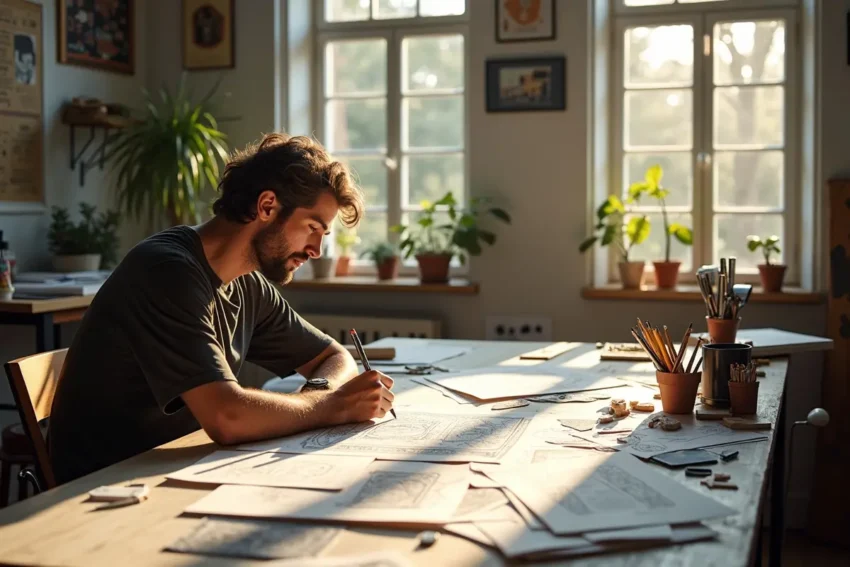Unplanned Perfection: Fun Ways to Let Randomness Guide Your Designs

Designing doesn’t always have to follow rigid plans or predictable patterns. In fact, embracing a bit of randomness can lead to surprisingly fresh and innovative results.
Allowing chance to play a role in the creative process can help break creative blocks, inspire new directions, and produce designs that feel dynamic and authentic. Whether working on interiors, fashion, digital graphics, or branding, using random methods strategically can spark creativity in unexpected ways.
Contents
Using Randomization Tools to Spark Ideas
Structured brainstorming can sometimes limit imagination. That’s where randomness can become a powerful creative tool. Digital platforms and physical objects like cards, spinners, or dice can provide prompts that push designers out of their comfort zones.
One effective method involves using an online dice roller to assign variables like color palettes, patterns, or layout choices. By rolling for outcomes, designers introduce elements they might not have chosen themselves, creating fresh combinations that challenge their usual approach.
This kind of exercise works well in collaborative settings. Teams can roll together to decide on stylistic directions, giving everyone a stake in the creative outcome while keeping the process lighthearted and experimental. Even solo designers can use these tools to reignite inspiration when their usual workflows start feeling repetitive.
Embracing Chance in Color Selection
Color is one of the most impactful elements of any design. Instead of always relying on tried-and-true palettes, randomness can be used to create unexpected but harmonious combinations. Designers might assign numbers to various colors and use random generators to select combinations. This approach often leads to surprising pairings that can feel bold and original.
Once a random palette is chosen, designers can refine the tones and shades to create balance without losing the sense of spontaneity. This method can help overcome the tendency to rely on favorite colors, pushing projects into new visual territory while maintaining aesthetic coherence.
Random Patterns for Textures and Layouts
Textures, patterns, and layouts give designs their personality. Introducing randomness into these elements can result in highly distinctive work. For example, randomly selecting textures or arrangement sequences can inspire unconventional compositions that still retain visual harmony. Designers can shuffle shape arrangements, pattern overlays, or grid structures to discover unexpected alignments that lead to more dynamic designs.
This technique works particularly well in fields like digital illustration, textiles, or web design, where layout variety can set a project apart. Even subtle randomized tweaks, like alternating margins or reversing expected alignments, can bring a sense of movement and vitality to the final product.
Creative Constraints Through Random Prompts
Paradoxically, randomness can introduce useful constraints that boost creativity. Designers can randomly assign limitations, such as restricting themselves to specific materials, colors, or shapes. These constraints force creative problem-solving, often resulting in designs that feel intentional yet innovative.
A designer might randomly select “circles only” for a poster layout or be required to use three unexpected materials for a home decor project. These limitations encourage new ways of thinking and can lead to solutions that feel fresh, clever, and unique.
Allowing Layouts to Evolve Organically
Instead of locking into a predetermined structure, designers can use randomness to guide layout evolution. By assigning positions or elements through random selection, layouts can develop in ways that surprise even the creator. This technique works well for magazine spreads, digital interfaces, or even interior room arrangements.
Once the randomized layout is in place, refinements bring everything together cohesively. This blend of structure and spontaneity creates designs that feel natural and energetic while maintaining functional clarity.
Encouraging Collaborative Play
Randomness can transform collaborative design sessions into exciting, creative experiments. Teams can use randomizers to assign responsibilities, themes, or visual elements, making the process more democratic and playful. Instead of a single designer dictating direction, everyone contributes ideas shaped by chance.
This leads to diverse and layered outcomes and strengthens team engagement. People feel more invested when their contributions are part of a collective creative game, often resulting in innovative group work that stands out.
Balancing Randomness and Refinement
While randomness can spark incredible ideas, refinement is what turns them into polished designs. Once the initial random decisions are made, designers should evaluate and adjust elements for balance, functionality, and audience appeal. Randomness serves as the starting point, but thoughtful editing ensures that the final product remains intentional and effective.
This balance between chance and control mirrors many real-world design processes, where inspiration might come unexpectedly, but execution requires precision and care.
Embracing randomness can breathe new life into any design process. From using dice to select color palettes to letting layouts evolve organically, chance-based methods encourage creativity, break habits, and introduce fresh perspectives. By blending unplanned elements with structured refinement, designers can create work that feels both innovative and well-crafted.
Whether working individually or in a team, randomness can become a reliable ally in the pursuit of bold and memorable designs.



